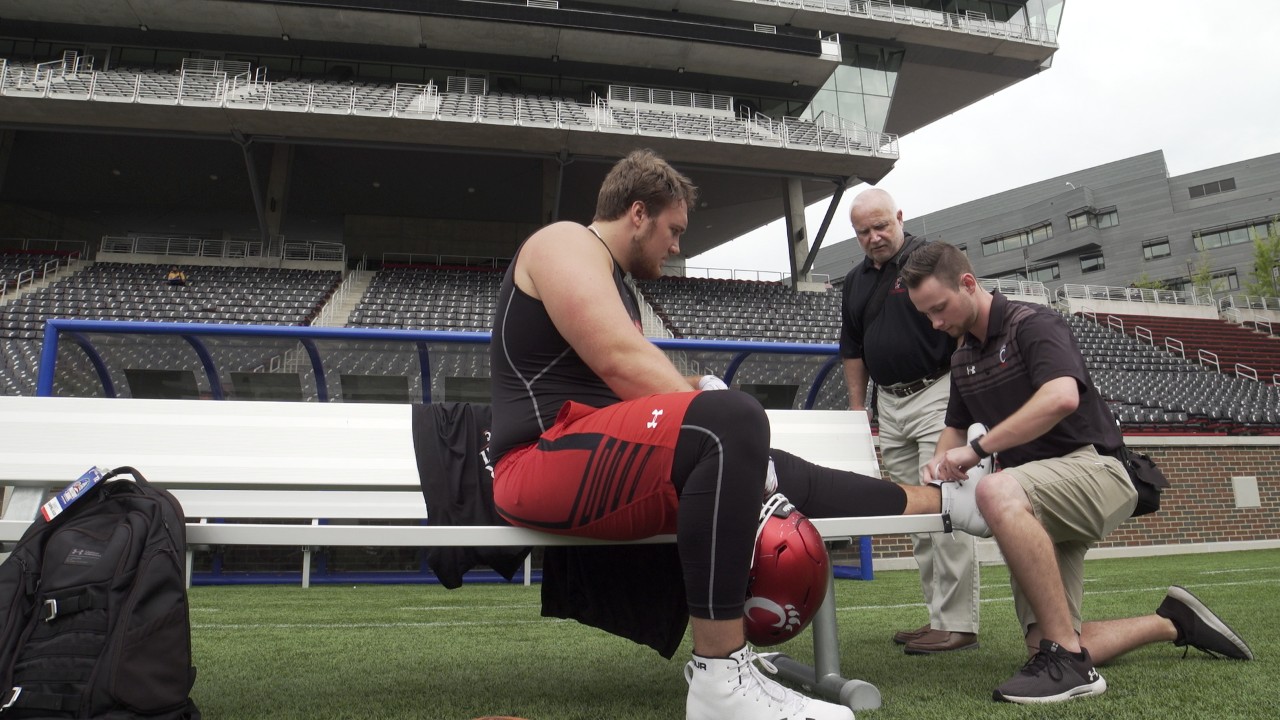
Athletic training education transitions to a master’s program
"Moving from a bachelor’s to a master’s-level structure benefits students, college, & profession"
In 1973, the University of Cincinnati (UC) Athletic Training Program consisted of five people: two staff athletic trainers and three students. One of those students, Tom Herrmann, would become the first UC graduate to earn his certification in the field. Today, the UC Department of Athletics is home to a dozen full-time staff members, and the Athletic Training Education Program in the College of Allied Health Sciences celebrated a spring 2020 graduating class of 15 students. Herrmann, who now serves as program director, is helping take the program to the next level. Students entering the program in Summer 2021 will now be earning a professional master's degree.
Nearly every athletic trainer I know has a master’s degree in something, but it wasn’t part of their professional training.
Tom Herrmann Athletic Training Program Director
Before joining the faculty at CAHS, Herrmann worked as an athletic trainer in collegiate athletics and as a faculty member in the UC Department of Orthopaedic Surgery. He then pursued a bachelor’s degree in physical therapy, working in private practice as a physical therapist. “There have always been a few professional master’s programs, but now they’re the requirement.”
This requirement Herrmann’s referring to transpired in 2017, when the Athletic Training Strategic Alliance announced that all athletic training students must obtain a master’s degree in order to be eligible for the national board exam, starting in 2027. According to the alliance, the “changing nature of health care and an increased emphasis on inter-professional practice will make the master’s level of education very important to the profession’s future.”
This decision forced colleges across the country to either completely restructure their athletic training programs to meet the new accreditation standards or shut them down. Terminating UC’s program was never considered, Herrmann says. Instead, he and his team sought to create an entirely new graduate program.
“The university is well identified as a strong player in athletic training education, but the graduate program is substantially different in approach and in the rules and regulations that guide it from the undergraduate program,” Herrmann says. “So when the last class of undergraduate students graduated in spring of 2020, we voluntarily withdrew our program’s accreditation, essentially archiving our undergraduate program, which gives our graduate program a clean start as a new accredited program.”
The first cohort of athletic training students will enter the new master’s-level program in the of Summer 2021. With the new structure, students will complete four years of undergraduate classes as a Health Sciences major, followed by two years—six consecutive semesters—of master’s-level courses in the athletic training program. Herrmann and his team designed the undergraduate curriculum so that students who are seriously committed to becoming an athletic trainer upon entering UC can apply to enter the graduate curriculum a year early, if they meet academic standards and complete the required 50 hours of pre-professional hours.
Prior to this transition, CAHS didn’t offer a graduate option for athletic training students, and graduate degrees were considered post-professional, meaning students would obtain them after earning their license. The new degree transition benefits both the students and the program, Herrmann says. For students, a master’s degree equates to increased employment rates, salaries and career longevity. For CAHS, it means the faculty can be more intentional with its education. Since the undergraduate curriculum is now better designed to equip students with the foundational information needed before learning the physical and psychological demands of working in the high-performance environments associated with athletic training. It’s also helpful that students are more mature entering the master’s-level program after three or four years of undergraduate studies, versus right out of high school.
Herrmann argues that the national transition also benefits the profession itself. “We were one of the few licensed health care professions left in the U.S. where you could get a license with a bachelor’s degree, so as professional stature goes, it moves the profession into the same academic preparation category as all of our cousins,” he says. “Whether or not that matters in the long run, I don’t know, but arguing that we were just as capable with less training was a difficult argument to make.”
Featured image: Athletic Training Program Director, Tom Herrmann instructs student at Nippert Stadiuim with student athlete. Photo/Colleen Kelley, UC Creative + Brand
The University of Cincinnati is the region's destination for thinking, making, doing, discovery and delivery. Next Lives Here.
Learn more about the Athletic Training program at the College of Allied Health Sciences.
Related Stories
ADAAPT: Growing Student Ideas
December 19, 2024
Steven Doehler, an industrial design professor at the University of Cincinnati’s College of Design, Architecture, Art, and Planning (DAAP), says he prioritizes the entrepreneurial aspect of a student's design product – which led him to create HomeGrown Studio.
What happens when you give co-op students 90 minutes to make a...
December 19, 2024
UC DAAP students on co-op at the Rockwell Group, an architecture firm in Manhattan, are featured in a Wall Street Journal article about the firm's gingerbread house competition. Check out their gingerbread replica of UC's Crosley Tower.
UC study examines delivery timing in mothers with chronic...
December 19, 2024
In a study recently published in the journal O&G Open, University of Cincinnati College of Medicine physician researchers found 39 weeks of gestation is optimal for delivery in mothers with chronic hypertension.